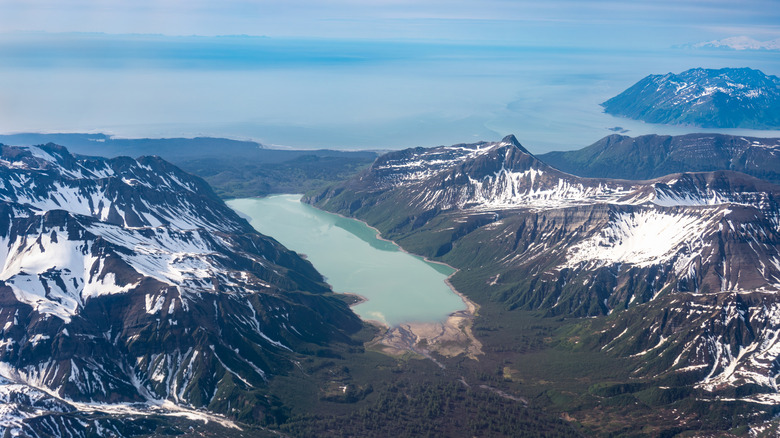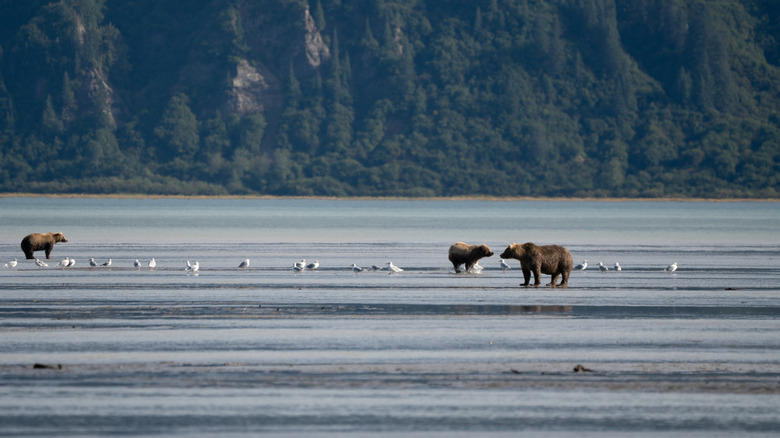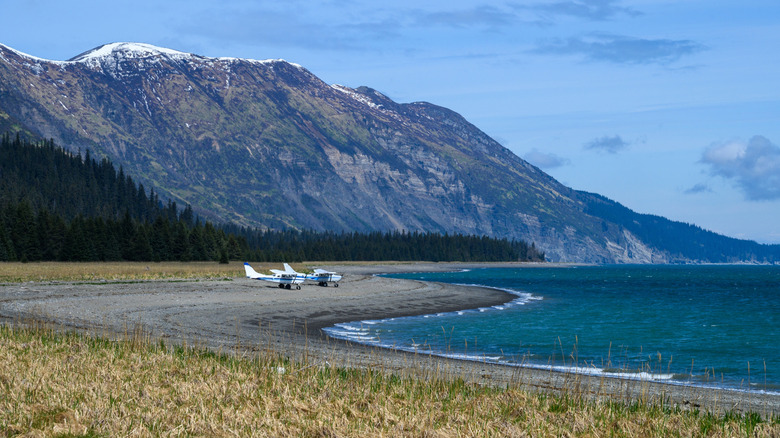One Of America's Most Dangerous Hikes Boasts Abundant Wildlife And Surreal Remote Landscapes In Alaska
Lake Clark National Park and Preserve is one of the most vast and beautiful national parks in the United States, but it's only visited by the most adventurous backpackers. This unique place is a completely unaltered Alaskan wilderness where those looking for a complete retreat from civilization can lose themselves (or maybe find themselves) in nature. There are no actual trails here, but some intrepid travelers still hike and camp here. Since there's no trail to follow, there are no limits on how and where you hike through Lake Clark National Park and Preserve — assuming that you're able to navigate. One of the most rugged and beautiful journeys through the preserve is a trek from Chinitna Bay to Silver Salmon Creek. This is an approximately 25-mile, multi-day journey through the rugged, remote landscape. Along the way, you'll see pine forests, chilly rivers, salt marshes, and towering jagged mountains covered in snow, silhouetted against the sky.
This route has been called one of the most dangerous trails in the United States, but unlike other notorious routes like the Grand Canyon's iconic Bright Angel Trail or Colorado's dangerous Capitol Peak hike, it's not the physical difficulty of the trek that makes it risky. Most of the way is fairly easy to walk. However, between the isolation, river crossings, and the high number of bears in the area, this is not an expedition to be undertaken lightly.
Watch for wildlife while backpacking in Lake Clark National Park and Preserve
Lake Clark is one of those national parks where you're almost guaranteed to see a bear, and both Chinitna Bay, where this incredible trek begins, and Silver Salmon Creek, where it ends, are best known for their abundance of brown bears. Because of the rivers coming down out of the mountains and into the bay, there's plenty here for bears to eat and enjoy. Bears come to this area to graze on plants that grow in the marshy areas around the bay and search for clams exposed by low tide in the spring and early summer, and to gorge themselves on salmon later in the year. There are several designated viewing areas where travelers may be able to spot up to 20 bears at a time. If you keep your eyes open, especially towards the end of your trip, you may even see moose and wolves, too. This is one of the best national parks for bird lovers, too. Keep an eye out for shorebirds, seabirds, and birds of prey along the way.
There are no campsites, so you'll need to bring everything for your trip with you — including food. Staying safe in bear country means securing your food, and anything a bear might interpret as possible food, like scented body wipes or strong-smelling bug sprays. Read up on the specific food storage requirements for Lake Clark from the National Park Service and make sure to follow their instructions. As exciting as it is to see a bear, you do not want to attract them to you. Park rangers often meet incoming hikers to go over bear safety, too, but when your safety is at stake, you should definitely come prepared with bear spray and electric bear fences, too.
How to hike from Chinitna Bay to Silver Salmon Creek
While Lake Clark National Park and Preserve is relatively close to Anchorage, Alaska, there's not a simple way of getting there — which is part of what makes this place so wild and remote. The standard way to get to Chinitna Bay, where this journey begins, is by chartering a small plane or air taxi. Make a backup plan with your air taxi for pickup, too. Things can go wrong on a hike like this, and you don't want to end up stranded because of an unexpected delay.
Once you arrive and begin your hike, you'll likely find that the hiking itself isn't too strenuous and you can stay on the beach — though there are some difficult areas that require rock hopping and river crossing. Just make sure that you understand what the tides are doing. The difference between high and low tide here is drastic, and the river crossings that you'll need to do become extremely dangerous when the tide is high. Some hikers even bring rafts just in case. Those traveling in this region are advised to use the Seldovia tide chart from NOAA and add a full 30 minutes for safety when trying to determine when the water will rise. Be prepared for heavy rains, too.
If you're not ready to spend the night alone with the bears in the Alaskan wilderness, there are other options. Consider starting with a day hike, and if you want to stay overnight, consider staying at Bear Mountain Lodge or Natural Habitat Adventures' Alaska Bear Camp in the Chinitna Bay region. If you want to go on a longer hiking trip but need some guidance, try booking with a licensed commercial company that offers guided bear overnight viewing trips in the area.


